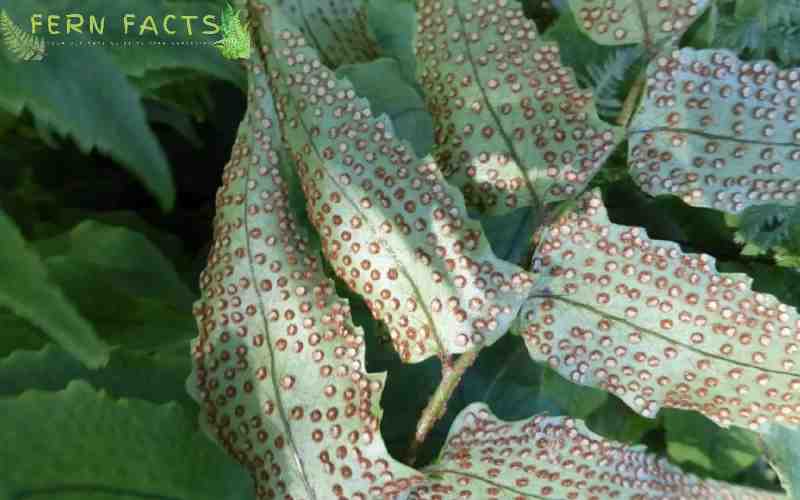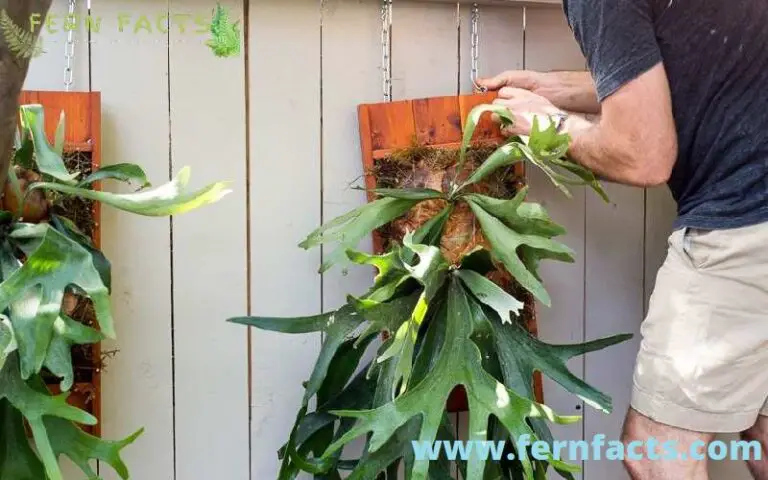Holly Fern – All You Need to Know
Japanese holly ferns are one of the native ferns in east asian countries, more than 35 species exist currently on the earth.
If you’re having a thought of buying this Japanese holly fern for your garden purpose, then this article is certainly for you. In this article, I’ll give the overall idea about the Japanese holly ferns along with their characteristics.
Later on, I’ll try to provide some guidelines in order to maintain these ferns. Additionally, I’ll highlight the repotting techniques, propagation techniques to you which will help you to have new plants as well.
Lastly, I’ll draw attention regarding these fern’s some common problems and troubleshooting methods. By following these methods and guidelines, you’ll have thriving green foliage holly ferns at your house.
So, let’s start overviewing the plant’s general characteristics and so on.
Overview of Holly fern

- Botanic name : Cyrtomium falcatum
- Family: Dryopteridaceae
- Common names: Japanese holly fern and house Holly fern
- Native region: Eastern Asia
- Plant: Perennial
- Hardiness zone: 6,7,8,9
- Height: around 18 to 24 inches
- Width: 24 to 36 inches
- Shade: partial shade or full shade
- Soil: well-drained
- Foliage color: green
- Flower: don’t have
- Fragrance: no fragrance
- Toxicity: non-toxic to dogs and cats
Japanese Holly ferns also known as house Holly fern which belongs to the wood family of Dryopteridaceae.
They are mostly native to eastern asia where you can find these fern in coastal cliffs, banks of the streams, rocky slopes and other moist stable places.
All About Japanese Holly Fern
Japanese Holly ferns are the ferns with glossy dark green lush appearances of holly branches. This Holly fern has 35 different varieties or species in East Asia.
These types of ferns are mostly native to Eastern asia such as China, Korea, Taiwan, Vietnam etc.
However, you can still find these ferns in different parts of North America, Hawaii and Australia as they cultivate these ferns there. These ferns prefer moist and well-draining soil to thrive and grow.
As it’s an evergreen plant that’s why it can’t survive in icy or frozen countries.
If you want to propagate these ferns then you can do both root division and spores collection method.
They also might need grooming and pruning when their shapes become slightly unpleasant, especially during the winter.
Additionally, they need full or partial shade to grow properly. They can even survive in low light conditions however, you should have given them some sort of indirect brightness where they can bloom.
Their ideal temperature would be 50°F however they can adapt themselves in the room temperature 68°F as well. These Japanese Holly ferns also don’t grow any flowers and have no fragrance.
Even, they are non toxic plants to animals which means they are not harmful especially cats and dogs.
Growing and Planting Japanese Holly Fern
In terms of growing and planting Japanese Holly ferns, you need to follow some basic and simple guidelines such as light conditions, soil, water, fertilizer, pruning and grooming techniques.
Similarly, propagating and troubleshooting holly fern pests and diseases issues. All these below mentioned guides will assist you to have your own Japanese Holly ferns plants at your house.
Light
Holly fern’s ideal light conditions prefer full shade or partial shade which means partial bright place or indirect sunlight. Similar to all other ferns, these holly ferns have less tolerance of direct sunlight.
Thus, you have to keep your ferns away from giving direct sun exposure or giving them direct sunlight. Excessive sun exposure can burn out their fronds.
You must give them ideal lighting for their ideal and active growth. You can also put them under low-light conditions but this will abruptly slow their growth.
That’s why you need to give them partial or fully shaded places with filtered sunlight.
Soil
Try to give them high quality potting mix which will help your ferns to reduce dryness and keep them moist along with well hydrated.
You can also choose soil with rich elements, and organic matter. And so, having well drainage soil is one of the best soil for these ferns which will absorb the excess water from the tip without drying too much.
Water
Watering techniques is another crucial factor for every plant as well as for Japanese Holly ferns. Routine and balanced water can make your plants thrive.
You have to water these Holly ferns until the water is moist; don’t pour too much water because they can’t tolerate standing water. Excessive water will soak their roots which will lead them to suffer from rotten roots conditions.
Therefore, you need to water them until the soil soaks up or absorbs the water and looks well hydrated, do not make the floating conditions.
In warmer or summer times, you can water them when the upper portion of soil is dried out.
Fertilizer
Additionally, feeding is another subcategory to have blooming and thriving holly ferns at your home.
During the warm month, you can fertilize your holly ferns once a week. Similarly, in winter seasons you can feed your ferns every trip for three weeks.
You can use liquid fertilizer because it will work miraculously for these types of ferns. Alternatively, you can also use slow-release fertilizer.
But make sure you avoid over feeding your plants which might lead to harm to your ferns.
Temperature
The best temperature for your ferns would be between 68° to 70° F. They can also tolerate lower temperatures.
Pruning
Pruning is one of the easiest jobs to do for these Japanese holly ferns. You just need to cut off any dried, dead or damaged fronds with scissors.
Generally, you can observe dead, damaged fronds in winter or early spring season. So, in those seasons you can do pruning of these ferns which will help your ferns to grow actively.
How to do Propagating of Japanese Holly ferns
You can apply two methods for Propagating this Japanese Holly fern. Either you can use the root division method or the spores collecting process method for propagating
Root Division Method
You can easily have many new plants or baby plants by dividing the roots of these Japanese Holly ferns. First, You can dig up the whole plant from the pot or the ground.
Try to wear gloves before propagation which will save you from injuries. Later dust off the soil from the plants.Then divide the roots from the main plants with any trowel or knife.
Try to ensure each part has the same sort of roots. Then replant each section into a pot or container or in your garden land.
After replanting the ferns try to locate them in a partially shaded place until you see some new growth in your Japanese holly ferns
Spores collection method
For this method, you need to collect any mature plants which have new spores on the underwear of the fronds. You can use any white paper to collect the spores from the fronds.
Later on just tap or flick the fronds with your finger slightly and let spores fall onto your paper slowly. Then mix the soil with rich fertilizer and spread the spores on the soil.
At first the spores will look like green color, later on it will turn into brown color during their matured period. You Need to make sure the spores don’t get direct sunlight because it can burn the spores.
Try to cover the spores with plastic wrap which will maintain the hydration. After one month remove the plastic wrap and mist them. Try not to forget to mist the soil regularly.
Over the passing time, you will spot green structures coming through from the soil surface of the ground if the process has been done successfully.
After noticing the first fronds try to water them consistently. When the new baby plants will have three to four fronds, you can easily replant or repot them in a container by following the above guidelines.
How to Repot Japanese Holly Ferns
For repotting the Japanese Holly ferns, you need to observe them thoroughly. If you observe they have become root-bound or the roots are already coming out from the pot that means your fern needs repotting.
In such cases, you have to choose a pot with a deeper container minimum of 2 inches bigger than the previous one.
Then, fill the pot with your new mixer soil with organic compost and matter. Then repot your ferns in the new container.
Make sure all roots are equally placed inside the container. Additionally, try to ensure you keep the plant’s crown above the soil to some degree which will prevent roots from rotting or decaying.

Common Problems With Japanese Holly Fern
Like all other ferns, these Japanese ferns also have some problems and issues. By taking care and troubleshooting you can have thriving holly plants.
Drying Fronds
These Japanese ferns have the tendency to dry out very quickly if the soil lacks moisture and hydration. Therefore, you need to follow the watering techniques consistently to solve this issue.
Pests Problems
The most common pests that attack this Japanese Holly fern are scale bugs. If you notice any yellow oval bumps on the stems and on the fronds of your plants, then certainly your ferns are being attacked by those pests.
In those cases, you need to use pesticides or any home remedy techniques such as mixing dish soap with water and mist your plants.
Root Rot
As they don’t tolerate standing water, therefore rotten roots are one of the main problems you might face if you don’t follow the correct instructions for watering.
If you see the soil become mushy and soggy along with lots of fungicides in the soil and roots. Immediately repot your plants with a new soil mixture.
Before mixing the soil, you can cut off the rotten roots or you can detach the roots and repot only healthy roots in the pot.
- Discover More About Caring for and Growing Macho Fern.
Final thought
On a final note, Japanese holly ferns have dark glossy green leaves with holly branches. Similarly to most of the ferns, they also prefer moist well drained soil and shaded areas.
If you want to grow these holly ferns at your house you can easily grow and plant these ferns by giving them the correct atmosphere such as light condition, soil, water, fertilizer, temperature, pruning and repotting.
Additionally, you can also propagate these ferns from roots and spores which will lead you to have multiple holly ferns in your garden land or in your house.
Thus, by troubleshooting their drying fronds, pests problems and rotten roots issue you can have healthy evergreen japanese holly ferns at your house to look at.







